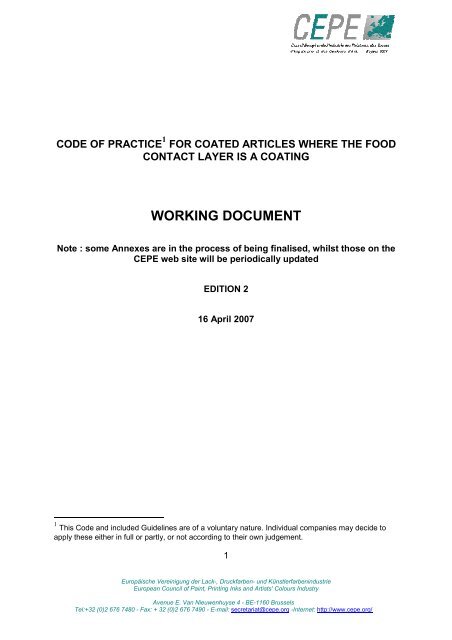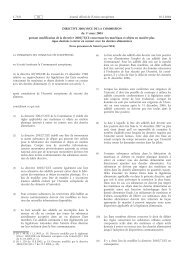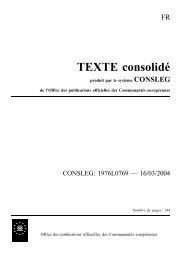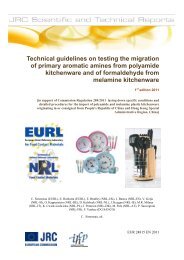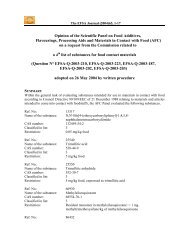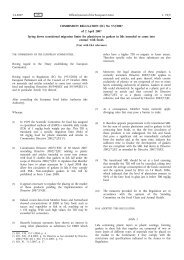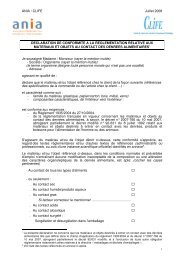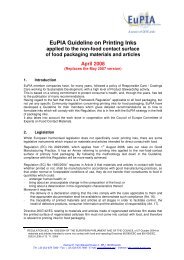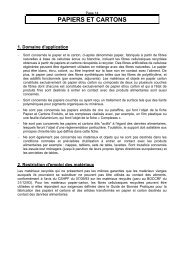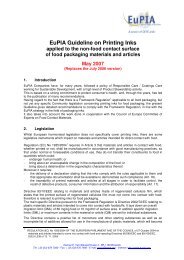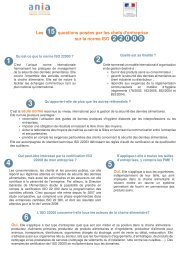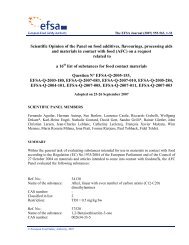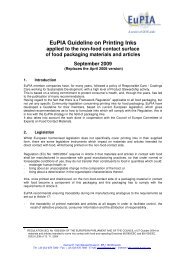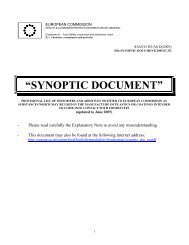WORKING DOCUMENT - Contact alimentaire
WORKING DOCUMENT - Contact alimentaire
WORKING DOCUMENT - Contact alimentaire
- No tags were found...
You also want an ePaper? Increase the reach of your titles
YUMPU automatically turns print PDFs into web optimized ePapers that Google loves.
ContentsArticle 1Article 2Article 3Article 4Article 5Article 6Article 7Article 8Article 9Article 10Article 11List of associations recommending this Code ofPracticeIntroductionSubject matter and scopeGood Manufacturing PracticeList of substances authorisedIncomplete list of monomers and other startingsubstancesIncomplete list of additivesSubstances having multiple functionsSpecific restrictions of substances (SML)Overall migration limit (OML)Rules for multilayer coatingsLabelling requirements, declaration of conformity andsupporting documentsDemonstration of compliance with OML, SML andQMA and evaluation of results2Europäische Vereinigung der Lack-, Druckfarben- und KünstlerfarbenindustrieEuropean Council of Paint, Printing Inks and Artists' Colours IndustryAvenue E. Van Nieuwenhuyse 4 - BE-1160 BrusselsTel:+32 (0)2 676 7480 - Fax: + 32 (0)2 676 7490 - E-mail: secretariat@cepe.org -Internet: http://www.cepe.org/
ANNEXESAnnex IAnnex IIAnnex IIIAnnex IVAnnex VAnnex VIAnnex VIIAnnex VIIIAnnex IXAnnex XAnnexXIOverview of how coated food contact articles aremanufacturedMonomers and other starting substancesList A - monomers and other starting substanceassessed by SCF/EFSAList B - monomers and other starting substances notassessed by SCF/EFSAAdditivesList C -additives assessed by SCF/EFSAList D - additives not assessed by SCF/EFSAGeneric description of resins used in food contactapplications and their componentsFood and food simulants to be used for testingcoatings in contact with foodsRisk assessment for migrants from coated articles incontact with foodstuffsBasic rules for demonstrating compliance with the OMLBasic rules for demonstrating compliance with SMLsGlossaryReferences to GMP’sList of substances considered as dual additives3Europäische Vereinigung der Lack-, Druckfarben- und KünstlerfarbenindustrieEuropean Council of Paint, Printing Inks and Artists' Colours IndustryAvenue E. Van Nieuwenhuyse 4 - BE-1160 BrusselsTel:+32 (0)2 676 7480 - Fax: + 32 (0)2 676 7490 - E-mail: secretariat@cepe.org -Internet: http://www.cepe.org/
Article 3Lists of substances authorised1. Those substances referred to in Articles 4 and 5 may be used in the manufactureof coatings intended to come into contact with foodstuffs subject to the conditionsand restrictions specified therein. The substances covered belong to the followingcategoriesa) monomers and other starting substances (see Annex II)b) additives (see Annex III)2. Additionally, non-listed monomers and other starting substances and additiveswhich are intentionally added may be used provideda. they do not migrate 1andb. they are not Class 1 and 2 CMRs as defined by 67/548/EEC and itsamendmentsandc. the Declaration of Compliance contains a statement that the nomigrationprinciple is used for compliance.EXPLANATORY NOTENon-listed monomers and other starting substances and additives, which areknowingly added and which are not carcinogenic or mutagenic or reprotoxic tomankind, are considered not to pose a threat to human health, provided they do notmigrate at a detection limit of 10µg/kg. Declaring the presence of such substances,which are knowingly added, in the Declaration of Compliance ensures that all in thesupply chain know of their existence and are aware of what is required to meet thisno migration requirement.1 With a detection limit of 10 µg/kg into food or food simulants.9Europäische Vereinigung der Lack-, Druckfarben- und KünstlerfarbenindustrieEuropean Council of Paint, Printing Inks and Artists' Colours IndustryAvenue E. Van Nieuwenhuyse 4 - BE-1160 BrusselsTel:+32 (0)2 676 7480 - Fax: + 32 (0)2 676 7490 - E-mail: secretariat@cepe.org -Internet: http://www.cepe.org/
2.4 The substances on the temporary appendix should be subjected toadditional toxicological information depending on their migration intofoodstuffs or the level of exposure to those substances. Exposureassessments may only be used when all relevant food contact sources ofexposure are identified.a. migration below 10 ppb - substances do not need further testingb. migration below 50 ppb – these substances should have themutagenicity tests according to REACH timeframesc. migration above 50 ppb – the supply chain needs to set up commoninterest groups in order to submit a dossier to EFSA.d. Whilst the migration may exceed 10ppb, if it can be demonstrated thatthe exposure is below 10 µg/person/day, then no further testing isrequired.e. It may also be possible to revise the requirements for cases b and c bythe use of exposure assesments.EXPLANATORY NOTEA number of the monomers and other starting substances currently used have notbeen fully assessed by SCF/EFSA, mainly because they are specifically used forcoatings. In order that they can continue to be used, they must have authorisation byat least one member state or be listed by the FDA. It is intended that the substances,which are used and are not on SCF Lists 0-4, will be subjected to toxicological testingor exposure assessments as described above.3. In addition to those substances in the list in Annex II, any substances which havean SCF or EFSA opinion (list SCF 0-4) may be used for the manufacture of thecoatings for direct food contact, subject to any restrictions applicable to them.EXPLANATORY NOTEThe current list of monomers and other starting substances reflects those currentlyused to manufacture coatings, which are in contact with food. Industry reserves theright to use any fully evaluated (SCF 0-4) substance, but not-listed in Annex II, infuture developments, as an SCF/EFSA opinion exists. As this list is regularly updatedthese substances, will eventually appear on a future revision.11Europäische Vereinigung der Lack-, Druckfarben- und KünstlerfarbenindustrieEuropean Council of Paint, Printing Inks and Artists' Colours IndustryAvenue E. Van Nieuwenhuyse 4 - BE-1160 BrusselsTel:+32 (0)2 676 7480 - Fax: + 32 (0)2 676 7490 - E-mail: secretariat@cepe.org -Internet: http://www.cepe.org/
4. Substances authorised as direct food additives, which can also be used in directfood contact coatings are listed in Annex XI. If the migration exceeds 10 µg per 6dm² then their identity will be given in the Declaration of Compliance.EXPLANATORY NOTEIn this context the dual use additive is used as a monomer thereby being consumedin the preparation of the polymer. Residual levels are typically very low. Thesupplier has the option not to declare the identity if it can be demonstrated that themigration is below 10 µg per 6 dm².5. Authorised monomers and starting substances may be chemically reacted andthe resulting product (resin, polymer or pre-polymer) may be used in coatings fordirect food contact.EXPLANATORY NOTEGeneric descriptions of how these monomers and starting substances could be usedto generate materials incorporated into coatings for direct food contact are given inAnnex IV.Article 5Additives1. The present article does not apply to colourants and solvents.2. Those additives listed in Annex III may be used for the manufacture of coatingsfor direct food contact subject to the restrictions set out therein.3. The list in Annex III is sub-divided into Lists C and DList C: list of additives assessed:3.1 Substances evaluated by SCF/EFSA, classified in list SCF 0-4 and used incompliance with specific migration limits or other restrictions, if any3.2 Additives approved by member states based or by any competent authoritiesupon an evaluation of a toxicological dossier which meets the presentSCF/EFSA criteria.12Europäische Vereinigung der Lack-, Druckfarben- und KünstlerfarbenindustrieEuropean Council of Paint, Printing Inks and Artists' Colours IndustryAvenue E. Van Nieuwenhuyse 4 - BE-1160 BrusselsTel:+32 (0)2 676 7480 - Fax: + 32 (0)2 676 7490 - E-mail: secretariat@cepe.org -Internet: http://www.cepe.org/
EXPLANATORY NOTEIn the case of polymeric additives made from complex raw materials, such aspetroleum distillates, HARRPA has discussed this issue with the Commissionand a distinction between polymers which can form articles and those whichcannot was agreed. A similar debate will be needed to resolve this issue forcoatings.List D: temporary appendix to List C (incomplete list of additives assessed).3.4 Substances approved by EU Member states or by FDA, not meeting thecriteria of 3.3.3.5 The substances on the temporary appendix should be subjected toadditional toxicological information depending on their migration intofoodstuffs or the level of exposure to those substances. Exposureassessments may only be used when all of the potential food contactapplications are identified.a. migration below 10 ppb - substances do not need further testingb. migration below 50 ppb – these substances should have themutagenicity tests according to REACH timeframesc. migration above 50 ppb – the supply chain needs to set up commoninterest groups in order to submit a dossier to EFSA.d. Whilst the migration may exceed 10ppb, if it can be demonstrated thatthe exposure is below 10 µg/person/day, then no further testing isrequired.e. It may also be possible to revise the requirements for cases b and c bythe use of exposure assesments.EXPLANATORY NOTEA number of the additives currently used have not been fully assessed bySCF/EFSA, mainly because they are specifically used for coatings. In order that theycan continue to be used, they must have authorisation by at least one member stateor be listed by the FDA. It is intended that the substances, which are used and arenot on SCF Lists 0-4, will be subjected to additional toxicological testing or exposureassessment as described above.13Europäische Vereinigung der Lack-, Druckfarben- und KünstlerfarbenindustrieEuropean Council of Paint, Printing Inks and Artists' Colours IndustryAvenue E. Van Nieuwenhuyse 4 - BE-1160 BrusselsTel:+32 (0)2 676 7480 - Fax: + 32 (0)2 676 7490 - E-mail: secretariat@cepe.org -Internet: http://www.cepe.org/
4. In addition to those substances in the list in Annex III any substances which havean SCF or EFSA opinion (list SCF 0-4) may be used for the manufacture ofcoatings for direct food contact, subject to any restrictions applicable to them.EXPLANATORY NOTEThe current list of additives reflects those currently used to manufacture coatings,which are in contact with food. Industry reserves the right to use any fully evaluated(SCF 0-4) substance, but not-listed in Annex III, in future developments, as anSCF/EFSA opinion exists. As this list is regularly updated these substances, willeventually appear on a future revision.5. When used as additives, natural or synthetic polymeric substances provided theirmonomers are listed in Annex II and they comply with the requirements of thisCode of Practice may be used.6. Substances authorised as direct food additives, which could be used in direct foodcontact coatings are listed in Annex XI. When used as an additive their identitymust be given in the Declaration of Compliance.14Europäische Vereinigung der Lack-, Druckfarben- und KünstlerfarbenindustrieEuropean Council of Paint, Printing Inks and Artists' Colours IndustryAvenue E. Van Nieuwenhuyse 4 - BE-1160 BrusselsTel:+32 (0)2 676 7480 - Fax: + 32 (0)2 676 7490 - E-mail: secretariat@cepe.org -Internet: http://www.cepe.org/
Article 6Substances having multiple functions1. Substances referred to in Articles 4 and 5, which are listed in Annex XI should besubject to the rules in Articles 4.4 and 5.6 with the relevant information beinggiven in the Declaration of Compliance (see Article 10).Article 7Specific restrictions of substances1. Coated articles for direct food contact shall not transfer their constituents to thefoods or food simulants as set out in Annex V in quantities exceeding therestrictions established in Annexes II and III.2. Wherever possible TDIs should be used as the SMLs are derived from their usein plastics. However in order to use TDIs it is necessary to have supportingexposure data. In the absence of exposure data the default assumption of 1 kgfood packaged in 6 dm² is applicable, thus the SMLs apply.3. The SMLs (Specific Migration Limits) in the lists set out in Annexes II and III areexpressed in mg (of substance)/kg (of food or food simulant). However, suchlimits and the levels of migration measured are expressed in mg/6dm² (of surfacearea of material or article in food contact) in the following cases:a containers and other articles which can be filled, with a capacity of lessthan 500 ml or 500 gramsb Coated films and sheets and other articles which cannot be filled or forwhich it is impossible to estimate the relationship between the surface areaof such material or articles and the quantity of food in contact therewith.4. In the cases described under 2(a) and 2(b), the limits set out in Annexes II and IIIexpressed in mg/kg shall be divided by the conventional conversion factor of 6 inorder to express them in mg/dm². This conversion is based on the assumptionthat 1 kg of food is in contact with 6 dm² of packaging.5. The use of non-regulated simulant substitutes can only be used to demonstratecompliance but cannot be used to demonstrate non-compliance. Non-regulatedsimulants can only be used when it has been demonstrated that they representworse or equal case than regulated simulants.6. For repeat use articles refer to the rules in Annexes VII & VIII.15Europäische Vereinigung der Lack-, Druckfarben- und KünstlerfarbenindustrieEuropean Council of Paint, Printing Inks and Artists' Colours IndustryAvenue E. Van Nieuwenhuyse 4 - BE-1160 BrusselsTel:+32 (0)2 676 7480 - Fax: + 32 (0)2 676 7490 - E-mail: secretariat@cepe.org -Internet: http://www.cepe.org/
Article 8Overall migration limit (OML)1. Coated articles for direct food contact shall not transfer their constituents to foodsor the food simulants set out respectively in Annex V in quantities exceeding 60milligrams / 6dm². It should be noted that the test protocols defined for plastics in2002/72/EC and its amendments and other relevant legislation may not beappropriate for all coated articles.EXPLANATORY NOTE3% acetic acid as a stimulant for acidic foodstuffs is inappropriate for both heavy dutycoatings and coatings for light metal packaging due to the fact that a significant partof the substrate can be corroded and contribute to the OML. This is further discussedin Annex VII.2. For coatings for heavy duty articles the OML is expressed in milligrams (ofsubstance)/ Kilogram (of food or food simulant) and may not exceed 60milligrams/ Kilogram food or food simulant.3. For closures, stoppers or similar devices for sealing the overall migration from thecoated surface is expressed in milligrams / kilogram (of food or simulant) andmust not exceed 60 milligrams/kilogram of food or food simulant taking account ofthe analytical toleranceArticle 9Rules for multilayers of coatings for direct food contactIn some instances more than one layer of a coating may be applied to the foodcontact side of the coated article.1. Each coating layer shall comply with the rules given in Articles 3, 4 and 5.2. The SMLs apply to the coated article independent of the coating layer where thesubstance is present.3. The finished article shall comply with the OML16Europäische Vereinigung der Lack-, Druckfarben- und KünstlerfarbenindustrieEuropean Council of Paint, Printing Inks and Artists' Colours IndustryAvenue E. Van Nieuwenhuyse 4 - BE-1160 BrusselsTel:+32 (0)2 676 7480 - Fax: + 32 (0)2 676 7490 - E-mail: secretariat@cepe.org -Internet: http://www.cepe.org/
Article 10Labelling requirements, compliance declaration and record-keeping ofcompliance supporting documentation1. The labelling requirements in Article 15 of the Framework Regulation (EC) No1935/2004 shall apply.2. In the application of Article 16(1) of the Regulation (EC) No 1935/2004, at themarketing stages other than the retail stages, coated materials and articles,coatings and their raw materials shall be accompanied by a written declaration,appropriate to their position in the supply chain.The written compliance declaration shall provide adequate and relevantinformation at each stage of the supply chain to help ensure the suitable use andsafety of the materials and articles subject to the declaration and their compliancewith relevant regulations. The written declaration shall be reviewed regularlyand/or when there is a significant change in the composition of the material andarticle. The declaration of compliance shall contain the following information:a. Name and address of the company which manufactures or imports thefinished material or article;b. Trade name;c. Identity of the raw material, coating or coated article;d. Date of the declaration;e. The confirmation that the material or article complies with, this code ofpractice, the requirements of appropriate EU Regulation and, whenappropriate, of national law under the conditions of use identified undersub-paragraph (g) hereunder. The references of the legislation compliedwith shall be quoted.f. Adequate information relative to the substances used for which specificrestrictions are in place under this Code of Practice and relevantCommunity or national legislation to allow the downstream user to ensurecompliance with those restrictions and list of substances used for which anSML or specifications are established.g. Depending upon their position in the supply chain, specifications on the useof the material or article such as(i)(ii)type or types of food;time and temperature of storage or treatment of the said material orarticle;(iii) surface volume ratio used for compliance assessment.17Europäische Vereinigung der Lack-, Druckfarben- und KünstlerfarbenindustrieEuropean Council of Paint, Printing Inks and Artists' Colours IndustryAvenue E. Van Nieuwenhuyse 4 - BE-1160 BrusselsTel:+32 (0)2 676 7480 - Fax: + 32 (0)2 676 7490 - E-mail: secretariat@cepe.org -Internet: http://www.cepe.org/
EXPLANATORY NOTEThe above will be updated in line with changes in Article 9 of the 4 thamendment to 2002/72/EC – EMB/1105, subject to agreement by thesignatories to this Code of Practice. The content of the Declaration ofCompliance is still under debate, and it is the intention that this Article willreflect whatever is agreed in the wider arena. The major concern isconfidentiality of proprietary information.Current discussions between sectors in the supply chain show a preferencefor a two part Declaration of Compliance. The first part will be generic andavailable to anyone. The second part will contain confidential informationexchanged between parties under appropriate secrecy agreement.h. in the absence of specific community implementing measures, referenceshall be made to national legislation applicable.i. A statement whether or not non-listed monomers and other startingsubstances or additives referred to in Article 3.2, are intentionally used.j. A statement whether or not substances, which are also dual additives aslisted in Annex XI, are intentionally used in line with the requirements givenin Articles 4.4 and 5.6.k. On request, a statement whether or not substances in temporary lists B orD are present.EXPLANATORY NOTEThe content of the Declaration of Compliance is still under debate. Depending uponthe outcome, either the presence or identity of the substances referred to in k will bedeclared, subject to confidentiality.Sub-sections i,j and k are additional to the requirements in the 4 th Amendment of2002/72/EC.3. Appropriate documentation to demonstrate that the products comply with therelevant requirements shall be made available by the business operator to thenational competent authorities on demand. This documentation shall contain,as is relevant for the product and their place in the supply chain:(a) information as regards their compliance with this code of practice18Europäische Vereinigung der Lack-, Druckfarben- und KünstlerfarbenindustrieEuropean Council of Paint, Printing Inks and Artists' Colours IndustryAvenue E. Van Nieuwenhuyse 4 - BE-1160 BrusselsTel:+32 (0)2 676 7480 - Fax: + 32 (0)2 676 7490 - E-mail: secretariat@cepe.org -Internet: http://www.cepe.org/
(b) results of testing, calculation, other analysis, evidence on the safety orreasoning demonstrating compliance. (Internationally recognized scientificprinciples, including exposure assessment, may be used)Article 11Compliance with OML, SML and QMA and evaluation of results1. Compliance testing regarding OML and SML in food or food simulants shall becarried out in accordance with the rules laid down in Annexes VII and VIIIrespectively.2. Compliance with QMA shall be carried out in accordance with the rules laid downin Annex VII.3. Compliance with the SML can be demonstrated also on the basis of otherconclusive experimental data or scientific evidence or a scientific reasoning.Some indications for the application of this Article are referred to in Annexes VIII.4. The results obtained in migration testing with food prevail over the resultsobtained with any type of simulant and simulant substitute.5. The results obtained in migration testing with a regulated simulant, i.e. referencefood simulant or regulated simulant D substitutes prevails over the resultsobtained with a non-regulated simulant.6. Non-regulated simulants / organic solvents / extractants can be used todemonstrate compliance, provided they represent the worse case or equal forappropriate regulated simulants, but not non-compliance.7. For repeated use articles, the rules are given in Annexes VII & VIII.19Europäische Vereinigung der Lack-, Druckfarben- und KünstlerfarbenindustrieEuropean Council of Paint, Printing Inks and Artists' Colours IndustryAvenue E. Van Nieuwenhuyse 4 - BE-1160 BrusselsTel:+32 (0)2 676 7480 - Fax: + 32 (0)2 676 7490 - E-mail: secretariat@cepe.org -Internet: http://www.cepe.org/
ANNEX IOVERVIEW OF HOW COATED FOOD CONTACT ARTICLES AREMANUFACTUREDA. COATED LIGHT METAL PACKAGING1. Definition of coatings for light metal packagingThese are coatings applied onto rigid metal, typically steel or aluminium, tomanufacture food cans, beverage cans, can ends, metal closures, aerosols andtubes. For canned food and beverage, aerosols and tubes, volumes would be in therange 25 – 5,000 cm 3 .2. ProductionCoatings for light metal packaging are produced by batch processes using goodmanufacturing processes.3. Application and curingCoatings for light metal packaging are applied under controlled factory conditionsusing good manufacturing practice. Coatings can be applied either on pre-formed /partially formed or on flat substrates using suitable methods of application beforeundergoing thermal treatment. Suitability of the application method is based on theperformance of the process and the coated product. In most cases some degree ofdeformation occurs after curing the coating in order to form the finished article. Filmthicknesses typically vary between 5 – 15 µm. The coatings are typically cured athigh temperatures.4. Conditions of useCoatings for light metal packaging are developed taking into account a number ofparameters, such as :Type of application – sheet vs coil, roller coat vs sprayType of metal – aluminium, steel (tinplate, tin-free steel)Deformation(s) required to form finished articleType of food to be packaged and its processing, if any, during the filling andtreatment operations.Migrants from the cured coatingSurface to volume ratios can vary from < 6dm²/kg to about 19 dm²/kg, dependingwhether it is a catering pack or a small fish can. In the case of metal closures therange is about 0.1 to 4.0 dm²/kg.20Europäische Vereinigung der Lack-, Druckfarben- und KünstlerfarbenindustrieEuropean Council of Paint, Printing Inks and Artists' Colours IndustryAvenue E. Van Nieuwenhuyse 4 - BE-1160 BrusselsTel:+32 (0)2 676 7480 - Fax: + 32 (0)2 676 7490 - E-mail: secretariat@cepe.org -Internet: http://www.cepe.org/
B. DRUMS AND PAILS1. Definition of coatings for drums and pails.These are coatings applied onto rigid metal, typically steel, to manufacture pailsand drums. Pails are open top containers with volumes between 5 and 25 L;drums can be open top or tight head with volumes up to 250 L.2. ProductionCoatings for pails and drums are produced by batch processes using goodmanufacturing processes.3. Application and curingCoatings for pails and drums are applied under controlled factory conditions,using good manufacturing practice. Coatings are generally spray-applied onseparate drum components with a typical film thickness between 12 and 20microns and are cured at 220 to 230 o C for 10 minutes.4. Conditions of useCoatings for pails and drums are developed, taking into account the type of foodto be packaged and other requirements.Surface to volume ratios can vary from
4. Conditions of useLarge containers are continuously emptied and refilled (so-called repeat use). Thismeans that migration into foodstuffs will be gradually reduced. The total service life ofa heavy duty coating system may be more than 20 years. Typical migration would beexpected to become very low during the service life.The surface to volume ratio has a positive influence by reducing the migration intofoodstuffs. The surface to volume ratio of a typical 10,000 litre container is 0.42dm²/kg, compared with the convention of 6 dm²/kg used in the EU for food packagingmaterials. This means that the EU convention of assuming a factor of 6 betweenmigration expressed as mg/dm² packaging material and that expressed as mg/kg(ppm) food is 14-fold greater than the worst case (i.e. smallest volume) for containersprotected with heavy duty coatings.Of course, many containers (e.g. ship tanks, land storage tanks) are far larger thanthe 10,000 litre minimum used to define heavy duty coatings.Examples:Container: 10,000 litresDimensions 10 by 10 by 100 dmSurface area: 4200 dm²Container 10,000 litresRoad container 3 metres long and 1.03 metre radiusSurface area: 2600 dm²These typical conditions of use have resulted in an exemption of heavy duty coatingsfrom the Epoxy Directive 2002/16/EC and its amendments, including Directive2004/13/EC and Regulation (EC) No /1895/2005.E. COATED FLEXIBLE ALUMINIUM PACKAGING1. DefinitionCoated Flexible Aluminium Packaging consists of products where coatings areapplied to aluminium or multilayer substrates where one layer is aluminium.Aluminium used for this purpose is typically of thicknesses up to 200 µm.Applications would include: individual wrappers, lidding, diaphragms, caps, blisterpacks composite cans and food containers.2. ProductionCoatings for flexible aluminium packaging are produced in batch processes usinggood manufacturing practices.22Europäische Vereinigung der Lack-, Druckfarben- und KünstlerfarbenindustrieEuropean Council of Paint, Printing Inks and Artists' Colours IndustryAvenue E. Van Nieuwenhuyse 4 - BE-1160 BrusselsTel:+32 (0)2 676 7480 - Fax: + 32 (0)2 676 7490 - E-mail: secretariat@cepe.org -Internet: http://www.cepe.org/
3. ApplicationCoatings for flexible aluminium packaging are applied under controlled productionconditions using good manufacturing practices.Coatings may consist of thermoplastic, thermo set, or organic solvent / water freeliquids (e.g. post lubrication).These coatings may be applied by various means such as, but not limited to, rollercoating, printing, spraying and dipping.4. Conditions of UseCoated flexible aluminium packaging may be used in retail, domestic or cateringsectors.Depending on the type of specification, the packaging may be subjected tosterilization, retorting or cooking processes at filler stages. Likewise, storage could beat ambient, refrigerated or at frozen conditions. The specific packaging may besubjected to defrosting or re-heating before the end of its life cycle.Suitability of the flexible aluminium packaging should be ascertained for specificapplications prior to its use.23Europäische Vereinigung der Lack-, Druckfarben- und KünstlerfarbenindustrieEuropean Council of Paint, Printing Inks and Artists' Colours IndustryAvenue E. Van Nieuwenhuyse 4 - BE-1160 BrusselsTel:+32 (0)2 676 7480 - Fax: + 32 (0)2 676 7490 - E-mail: secretariat@cepe.org -Internet: http://www.cepe.org/
ANNEX IIINCOMPLETE 1 LIST OF MONOMERS AND OTHER STARTING SUBSTANCES1. This Annex contains the list of monomers or other starting substances. The listincludes:– substances undergoing polymerisation, which includes polycondensation,polyaddition or any other similar process, to manufacture macromolecules,– natural macromolecular substances used in the manufacture of modifiedmacromolecules, if the monomers or the other starting substances required tosynthesise them are not included in the list,– starting substances used to modify existing natural or synthetic substances.2. This list is subdivided into list A and list B.List A contains substances which have been assessed by SCF or EFSA and forwhich there is an opinion (classified in list SCF 0-4) and used in compliance withspecific migration limits or other restrictions if any and substances approved inmember states or by FDA, based on an evaluation of a toxicological dossier,which meets the present SCF/EFSA criteriaList B contains substances which have been approved by member states or byFDA, applying evaluation criteria at the time of their approval3. The following substances are not included even if they are intentionally used andare authorised:(a)(b)Salts (including double salts and acid salts) of aluminium, ammonium,calcium, iron, magnesium, potassium and sodium of authorised acids,phenols or alcohols. However, names containing '... acid(s), salts' appear inthe lists, if the corresponding free acid(s) is (are) not mentioned;Ionic salts (including double salts and acid salts) of metals of authorisedacids, phenols or alcohols. For these salts the restrictions applicable to theacid and cationic metal shall apply independently from their source’4. Substances shall be of good technical quality as regards the purity criteria.1 The list is claimed as being incomplete as it is based on the Council of Europedocuments which are updated on regular basis. It does not contain othersubstances which have an SCF or EFSA opinion (lists SCF 0-4 ) e.g.substances which are authorised for other food contact sectors.24Europäische Vereinigung der Lack-, Druckfarben- und KünstlerfarbenindustrieEuropean Council of Paint, Printing Inks and Artists' Colours IndustryAvenue E. Van Nieuwenhuyse 4 - BE-1160 BrusselsTel:+32 (0)2 676 7480 - Fax: + 32 (0)2 676 7490 - E-mail: secretariat@cepe.org -Internet: http://www.cepe.org/
5. The list contains the following information:– column 1 (PM/REF. No) : the EEC packaging material reference number ofthe substances on the list,– column 2 (CAS No) : the CAS (Chemical Abstracts) Registry number,– column 3 (Name) : the chemical name,– column 4 (Restrictions and/or specifications): These may include:– specific migration limit (SML),– maximum permitted quantity of the substance in the finished material orarticle (QM),– maximum permitted quantity of the substance in the finished material orarticle expressed as mg per 6 dm 2 of the surface in contact withfoodstuffs (QMA),– any other restriction specifically mentioned,– any type of specifications related to the substance or to the polymer,–6. If a substance appearing on the list as an individual compound is also covered bya generic term, the restrictions applying to this substance shall be those indicatedfor the individual compound.7. Where there is any inconsistency between the CAS number and the chemicalname, then the chemical name shall take precedence over the CAS number. Ifthere is an inconsistency between the CAS number reported in EINECS and theCAS Registry, then the CAS number in the CAS Registry shall apply.8. A number of abbreviations or expressions are used in column 4 of the table, themeanings of which are as follows:DL = detection limit of the method of analysis;FP = Whilst strictly speaking FP refers to finished plastic in this context it isreferring to any finished material or article;NCO = isocyanate moiety;ND = Not detectable. For the purpose of this Code of Practice “notdetectable” means that the substance should not be detected by avalidated method of analysis which should detect it at the detection limit(DL) specified. If such a method does not currently exist, an analytical25Europäische Vereinigung der Lack-, Druckfarben- und KünstlerfarbenindustrieEuropean Council of Paint, Printing Inks and Artists' Colours IndustryAvenue E. Van Nieuwenhuyse 4 - BE-1160 BrusselsTel:+32 (0)2 676 7480 - Fax: + 32 (0)2 676 7490 - E-mail: secretariat@cepe.org -Internet: http://www.cepe.org/
method with appropriate performance characteristics at the detectionlimit may be used, pending the development of a validated method;QM = maximum permitted quantity of the 'residual' substance in the materialor article;QM(T) = Maximum permitted quantity of the 'residual' substance in the materialor article expressed as total of moiety or substance(s) indicated. For thepurpose of this Code of Practice the quantity of the substance in thematerial or article should be determined by a validated method ofanalysis. If such a method does not currently exist, an analytical methodwith appropriate performance characteristics at the specified limit maybe used, pending the development of a validated method;QMA = Maximum permitted quantity of the "residual" substance in the finishedmaterial or article expressed as mg per 6 dm 2 of the surface in contactwith foodstuffs. For the purpose of this Code of Practice the quantity ofthe substance in the surface of the material or article should bedetermined by a validated method of analysis. If such a method doesnot currently exist, an analytical method with appropriate performancecharacteristics at the specified limit may be used, pending thedevelopment of a validated method;QMA(T) = Maximum permitted quantity of the "residual" substance in the materialor article expressed as mg of total of moiety or substance(s) indicatedper 6 dm² of the surface in contact with foodstuffs. For the purpose ofthis Code of Practice. the quantity of the substance in the surface ofthe material or article should be determined by a validated method ofanalysis. If such a method does not currently exist, an analytical methodwith appropriate performance characteristics at the specified limit maybe used, pending the development of a validated method;SML = Specific migration limit in food or in food simulant, unless it is specifiedotherwise. For the purpose of this Code of Practice the specificmigration of the substance should be determined by a validated methodof analysis. If such a method does not currently exist, an analyticalmethod with appropriate performance characteristics at the specifiedlimit may be used, pending the development of a validated method;SML(T) = Specific migration limit in food or in food simulant expressed as total ofmoiety or substance(s) indicated. For the purpose of this Code ofPractice the specific migration of the substances should be determinedby a validated method of analysis If such a method does not currentlyexist, an analytical method with appropriate performance characteristicsat the specified limit may be used, pending the development of avalidated method.26Europäische Vereinigung der Lack-, Druckfarben- und KünstlerfarbenindustrieEuropean Council of Paint, Printing Inks and Artists' Colours IndustryAvenue E. Van Nieuwenhuyse 4 - BE-1160 BrusselsTel:+32 (0)2 676 7480 - Fax: + 32 (0)2 676 7490 - E-mail: secretariat@cepe.org -Internet: http://www.cepe.org/
Lists A and B, including their updates, are available on the publication part of CEPEwebsite (under paint documents) at following link : http://www.cepe.org/These are also available on the Council of Europe website..27Europäische Vereinigung der Lack-, Druckfarben- und KünstlerfarbenindustrieEuropean Council of Paint, Printing Inks and Artists' Colours IndustryAvenue E. Van Nieuwenhuyse 4 - BE-1160 BrusselsTel:+32 (0)2 676 7480 - Fax: + 32 (0)2 676 7490 - E-mail: secretariat@cepe.org -Internet: http://www.cepe.org/
ANNEX IIIINCOMPLETE 1 LIST OF ADDITIVES1. This Annex contains the list of substances which are incorporated into coatings toachieve a technical effect in the finished product, including ‘polymeric additives’.They are intended to be present in the finished articles;For the purpose of this Annex, ‘Polymeric additives’ means any polymer and/orprepolymer and/or oligomer which may be added to coatings in order to achieve atechnical effect but which cannot be used in absence of other polymers as themain structural component of finished materials and articles. It includes alsosubstances which may be added to the medium in which polymerisation occurs.The list does not include:(a)(b)(c)the substances which directly influence the formation of polymers;the substances only used to provide a suitable medium in whichpolymerisation occurs (‘polymerisation production aids’)colourants and many pigments.2. This list is sub-divided into Lists C and DList C contains additives which have been assessed by SCF or EFSA and forwhich there is an opinion (classified in list SCF 0-4) and used in compliance withspecific migration limits or other restrictions if any and substances approved inmember states or by FDA, based on an evaluation of a toxicological dossier,which meets the present SCF/EFSA criteriaList D contains additives which have been approved by member states or byFDA, applying evaluation criteria at the time of their approval3. The following substances are not included even if they are intentionally used andare authorised:(a)Salts (including double salts and acid salts) of aluminium, ammonium,calcium, iron, magnesium, potassium and sodium of authorised acids,1 The list is claimed to be incompleted as it is based on the Council of Europedocuments which are updated on regular basis. It does not contain othersubstances which have an SCF or EFSA opinion (lists SCF 0-4 ) e.g.substances which are authorised for other food contact sectors.28Europäische Vereinigung der Lack-, Druckfarben- und KünstlerfarbenindustrieEuropean Council of Paint, Printing Inks and Artists' Colours IndustryAvenue E. Van Nieuwenhuyse 4 - BE-1160 BrusselsTel:+32 (0)2 676 7480 - Fax: + 32 (0)2 676 7490 - E-mail: secretariat@cepe.org -Internet: http://www.cepe.org/
(b)phenols or alcohols. However, names containing '... acid(s), salts' appear inthe lists, if the corresponding free acid(s) is (are) not mentioned;Ionic salts (including double salts and acid salts) of metals of authorisedacids, phenols or alcohols. For these salts the restrictions applicable to theacid and cationic metal shall apply independently from their source.’4. The current list of additives includes also some polymerisation production aids(PPA). Some of the PPA’s can also act as additives and, therefore they areincluded in Lists C and D. The others acting solely as a PPA will be regulatedlater, therefore they are excluded from the current definition of additives.5. Substances shall be of good technical quality as regards the purity criteria.6. The list contains the following information:– column 1 (PM/REF. No): the EEC packaging material reference number of thesubstances on the list,– column 2 (CAS No): the CAS (Chemical Abstracts Service) registry number,– column 3 (Name): the chemical name,– column 4 (Restrictions and/or specifications). These may include:– specific migration limit (SML),– maximum permitted quantity of the substance in the finished material orarticle (QM),– maximum permitted quantity of the substance in the finished material orarticle expressed as mg per 6 dm² of the surface in contact with foodstuffs(QMA),– any other restriction specifically laid down,– any type of specification related to the substance or polymer.7. If a substance appearing on the list as an individual compound is also covered bya generic term, the restrictions applying to this substance shall be those indicatedfor the individual compound.8. Where there is any inconsistency between the CAS number and the chemicalname, the chemical name shall take precedence over the CAS number. If there isan inconsistency between the CAS number reported in EINECS and the CASregistry, the CAS number in the CAS registry shall apply.29Europäische Vereinigung der Lack-, Druckfarben- und KünstlerfarbenindustrieEuropean Council of Paint, Printing Inks and Artists' Colours IndustryAvenue E. Van Nieuwenhuyse 4 - BE-1160 BrusselsTel:+32 (0)2 676 7480 - Fax: + 32 (0)2 676 7490 - E-mail: secretariat@cepe.org -Internet: http://www.cepe.org/
Lists C and D, including their updates, are available on the publication part of CEPEwebsite (under paint documents) at following link : http://www.cepe.org/These are also available on the Council of Europe website.30Europäische Vereinigung der Lack-, Druckfarben- und KünstlerfarbenindustrieEuropean Council of Paint, Printing Inks and Artists' Colours IndustryAvenue E. Van Nieuwenhuyse 4 - BE-1160 BrusselsTel:+32 (0)2 676 7480 - Fax: + 32 (0)2 676 7490 - E-mail: secretariat@cepe.org -Internet: http://www.cepe.org/
ANNEX IVGENERIC DESCRIPTION OF COATINGS TYPICALLY USED IN FOOD CONTACTAPPLICATIONS AND THEIR COMPONENTSANNEX IV.I - DESCRIPTION OF COATINGSCoatings typically consist of:1. Resins (synthetic or natural), polymers or prepolymers2. Crosslinking agents or crosslinking prepolymers or crossslinking resins. Note thatthese are present only in thermoset (or predominately) systems.3. Additives, such as waxes, pigments, lubricants, flow aids and defoamers4. Organic solvents and or water (not always)• Items 1-3 are designed to remain in the final film. In the case of thermosetsystems, the cured coating comprises a (densely) crosslinked polymeric matrixresulting from the reaction of items 1 with 2.• Coatings are normally applied in the wet state (although powder coatingsystems can also be used in contact with food), and cannot fulfil their desiredfunctions until organic solvent and or water (if present) has been removed,and, in the case of thermoset coatings, crosslinking of items 1 with 2 hasoccurred.• Organic solvent and water-free thermoplastic coatings rely on melting and resolidifyingto form the food contact layer.• Organic solvent and water-free thermoset coatings rely on crosslinking to formthe food contact layer, which may or may not involve a melting process.It is important that there is adequate crosslinking and / or removal of organic solventand or water otherwise this will result in the finished article being unsuitable for itsintended application.The resins or polymers used in coatings can be either thermoplastic or thermoset.Thermoplastic resins or polymers undergo little if any further intentional chemicalreactions with other components in the coating. As such they are typically of highmolecular weight and the final properties of the coating are normally inherent in thethermoplastic resins or polymers as mixed into the applied coating.Thermoset resins or polymers or prepolymers are specifically designed to undergochemical reactions (normally crosslinking or curing) either with other components inthe coating such as crosslinking agents or crosslinking prepolymers or crosslinkingresins or with themselves or any combination to form a final film which will be incontact with foodstuffs. Crosslinking agents can also be considered thermosetstarting materials. Typically the components intended to react with each other or31Europäische Vereinigung der Lack-, Druckfarben- und KünstlerfarbenindustrieEuropean Council of Paint, Printing Inks and Artists' Colours IndustryAvenue E. Van Nieuwenhuyse 4 - BE-1160 BrusselsTel:+32 (0)2 676 7480 - Fax: + 32 (0)2 676 7490 - E-mail: secretariat@cepe.org -Internet: http://www.cepe.org/
themselves are of lower molecular weight than a thermoplastic resin or polymer.Thermoset coatings develop their optimum mechanical properties and performancerequirements only when sufficient crosslinking reactions between the functionalgroups have occurred, which results in an increase in molecular weight.Resins or polymers or prepolymers or crosslinking agents or crosslinkingprepolymers or crosslinking resins are prepared only from monomers and otherstarting substances included in Annex II Lists A and B or are themselves on theselists.Thus it is necessary to describe how these substances are used to prepare relativelycomplex mixtures of resins or polymers or prepolymers as well as crosslinking resinsor crosslinking agents or crosslinking prepolymers. Due to their complexity, it isimpracticable to individually list all of the potential components present in the resinsor prepolymers or polymers or crosslinking agents or crosslinking prepolymers orcrosslinking resins mixed in the applied film. This is also the case for oligomers andisomers of substances in Lists A&B, even if some are relatively low molecular weightspecies. Thus to ensure uniformity of treatment for all resins or prepolymers orpolymers or crosslinking agents or crosslinking prepolymers or crosslinking resinsonly the building blocks for resins or polymers or prepolymers or crosslinking agentsor crosslinking prepolymers or crosslinking resins are listed. This informative Annexdescribes how these building blocks are combined and, as its name suggests, is forinformative purposes only. It is not exhaustive and in this context it is not a positivelist, but contains as much compositional information as is reasonably possible.Additives, including polymeric additives, cover a wide range of materials, many ofwhich are designed to improve the integrity of the final film. These would typically beflow aids, defoamers, plasticisers, whilst additives such as waxes are present toimprove the lubricity of the dried film. Waxes may also be used as a coating ratherthan an additive. In addition pigments could be present. Additives used are in AnnexIII Lists C and D or are polymeric being prepared from substances in Annex II Lists Aand B.The approach used in the informative annex consists of families of resins, furtherdefined by the types of substances in the inventory List of Monomers and otherstarting substances and Additives normally used in their manufacture and the typicalcombinations of the substances. An indication of the typical functional groups is alsogiven.The informative Annex consists of 2 sections in total:1. Overview of resins typically used2. Generic description of composition of typical resins, with functional groupspossibly present3. Overview of how the resins in 1 and 2 may be combined in a coating.32Europäische Vereinigung der Lack-, Druckfarben- und KünstlerfarbenindustrieEuropean Council of Paint, Printing Inks and Artists' Colours IndustryAvenue E. Van Nieuwenhuyse 4 - BE-1160 BrusselsTel:+32 (0)2 676 7480 - Fax: + 32 (0)2 676 7490 - E-mail: secretariat@cepe.org -Internet: http://www.cepe.org/
ANNEX IV.II – OVERVIEW OF DIFFERENT TYPES OF RESINS TYPICALLY USEDIN FOOD CONTACT COATINGSResins which may be used in coatings for direct food contact can be sub-dividedinto :1. Acrylics2. Alkyds3. Aminos4. Anhydrides5. Cellulosics6. Epoxies7. Hydrocarbon resins8. (Poly)Isocyanates9. Polyamides / polyamines10. Polyesters11. Phenolics12. Polyurethanes13. Vinylics14. Rosins and rosin derivatives15. Miscellaneous16. Polyethers17. Shellacs, ketone and latex33Europäische Vereinigung der Lack-, Druckfarben- und KünstlerfarbenindustrieEuropean Council of Paint, Printing Inks and Artists' Colours IndustryAvenue E. Van Nieuwenhuyse 4 - BE-1160 BrusselsTel:+32 (0)2 676 7480 - Fax: + 32 (0)2 676 7490 - E-mail: secretariat@cepe.org -Internet: http://www.cepe.org/
ANNEX IV.III - GENERIC DESCRIPTIONS OF COMPOSITION OF RESINSTYPICALLY USED IN FOOD CONTACT COATINGS AND POTENTIALFUNCTIONAL GROUPS WHICH COULD BE PRESENT.Note : Where resins are used to modify other resins then any of the functionalgroups present in the original resins may also be present1. Acrylics1.1 Acrylics prepared from a combination of monomers (co-monomers) on theInventory list of Monomers and Additives, such as methyl methacrylate, (PM21130), styrene (PM 24610), ethyl hexyl acrylate (PM 11500).Functional groups potentially present:Ester, aromatic and / or aliphatic residual >C=C< unsaturation1.2 Functional acrylics prepared from a combination of monomers (co-monomers)on the Inventory list of Monomers and Additives (as in 1.1) with functional comonomersfrom the Inventory list of Monomers and Additives, such as acrylic ormethacrylic acids (PM 10690 or 20020) or hydroxy ethyl methacrylate (PM20950).Functional groups potentially present:Ester, -OH, -COOH, -NH 2 , oxirane, aromatic and / or aliphatic residual >C=CC=C
Functional groups potentially present:hydroxyl, nitro (-NO 2 ).6. Epoxies6.1 Standard aromatic epoxy resins prepared from Epichlorohydrin (PM 16750) andbifunctional phenols included in the Inventory list of Monomers and Additives,such as Bisphenol A (PM 13480) or Bisphenol F (PM 13455/ 13457) to form anepoxy, which may be further reacted with the original phenol monomer and/orother phenolic monomers, such as p-t-butyl phenol (PM 14020).Functional groups potentially present:Oxirane, -OH, -ArOH, -C-N-C-6.2 Epoxy novolac resins prepared from Epichlorohydrin (PM 16750) and novolacprecursor resin made from formaldehyde (PM 17260) and phenols included inthe Inventory list of Monomers and Additives, typically Phenol (PM 22960).Functional groups potentially present:Oxirane, Ar-OH, -C-N-C-, -Ar-CH 2 -Ar-, -Ar-CH2-O-CH2-Ar-The use of epoxy novolacs in can coatings is not permitted, but they can beused in heavy duty coatings. For further details refer to Regulation (EC) No1895/2005.6.3 Epoxy-acrylic resins prepared from epoxies (6.1) which are further modified byreaction with acrylic/vinyl monomers included on the Inventory list of Monomersand Additives, such as Acrylic or Methacrylic acids (PMs 10690 or 20020) andStyrene (PM 24610), or further reacted with an acrylic resin (1.1 or 1.2)prepared from substances on the Inventory list of Monomers and Additives. Acidfunctionality may be neutralised by reaction with a (semi-) volatile amine, suchas dimethylaminoethanol (PM 16150).Functional groups potentially present:Oxirane, ester, -OH, R-COOH, aromatic and/or aliphatic residual >C=C
Oxirane, ester, -OH, Ar-COOH, R-COOH, aromatic and/or aliphatic residual>C=C< unsaturation6.5 Epoxy-amine adducts prepared from epoxy resins (6.1) which are furtherreacted with amine functional substances included in the Inventory list ofMonomers and Additives, such as ethylene diamine (PM 16960) or an aminefunctional intermediate or resin (9.1), prepared from substances included in theInventory list of Monomers and Additives, to form an epoxy adduct with residualamine functionality.Functional groups potentially present:-OH, R-NH 2 (from monomers), R-NH-R, imidazolines, tertiary amines,quaternary ammonium6.6 Reactive diluents: low molecular weight glycidylether/ester compounds preparedfrom Epichlorohydrin (PM 16750) reacted with mono-, bi- or multifunctionalalcohols, phenols or organic acids included in the Inventory list of Monomersand Additives. Reactive diluents are used as modifiers in epoxy based systemsto adjust viscosity or improve flexibility, typical examples include 1,4-Butanedioldiglycidylether (PM 13780) and Trialkyl (C5-C15) acetic acid glycidylester (PM14390)Functional groups potentially present:R-Oxirane, R-OH, R-COOH7. Hydrocarbon resinsHydrocarbon resins are polymers manufactured from various types ofmonomers. The raw material for these resins may be pure monomers, e.g.styrene, but often are based on complex distillates. Due to the complex natureof the structures of many of the monomers, industry has submitted the finalresins for evaluation by EFSA rather than their individual monomers. Due to thelow molecular weight, these resins cannot be used, in the absence of other(polymeric) components, as the main structural compound of the finishedarticles.Hydrocarbon resins may be hydrogenated or not.8. (Poly)isocyanates8.1 Isocyanates in the Inventory list of Monomers and Additives, such ashexamethylene diisocyanate (PM 18640) or diphenyl methane diisocyanate(PMs 16600, 16630) either reacted with themselves or with polyols in theInventory list of Monomers and Additives, such as trimethylol propane (PM25600).37Europäische Vereinigung der Lack-, Druckfarben- und KünstlerfarbenindustrieEuropean Council of Paint, Printing Inks and Artists' Colours IndustryAvenue E. Van Nieuwenhuyse 4 - BE-1160 BrusselsTel:+32 (0)2 676 7480 - Fax: + 32 (0)2 676 7490 - E-mail: secretariat@cepe.org -Internet: http://www.cepe.org/
Functional groups potentially present:Aromatic / aliphatic –NCO ; urethane, biuret, allophanateThe isocyanate functionality may be further reacted with a ‘blocking agent’ toenable single component coating formulations to be prepared. The blockingagent evaporates on heating, thereby regenerating the isocyanate functionality.9. Polyamides / polyamines9.1 Amines in the Inventory list of Monomers and Additives, such as diethylenetriamine (PM 15790), reacted with acid functional substances in the Inventorylist of Monomers and Additives, such as dimerised fatty acid (PM 17233) and /or monofunctional acids, such as tall oil fatty acid (PM 17230) to produce anamine functional resin.Functional groups potentially present:-COOH, -NH 2 , -NH-, CONH 2 , imidazolines9.2 Epoxy resins (6.1) reacted with an amine functional substance in the Inventorylist of Monomers and Additives, such as ethylene diamine (PM 16960) or anamine functional intermediate or resin (9.1), prepared from substances in theInventory list of Monomers and Additives, to form an epoxy adduct with residualamine functionality.Functional groups potentially present:Oxirane, -OH, -NH 2 , -NH-, imidazolines10. Polyesters10.1 Polyesters prepared by the reaction of polyacids in the Inventory list ofMonomers and Additives such as adipic acid (PM 12130), terephthalic acid (PM24910), isophthalic acid (PM 19150) and possibly monofunctional acids, such asbenzoic acid (PM 13090), with polyols listed in the Inventory list of Monomersand Additives, such as neopentyl glycol (PM 16390), ethylene glycol (PM16990), butanediol (PMs 13690, 13720), trimethylol propane (PM 25600).Functional groups potentially present:R-OH, R-COOH, Ar-COOH, esters10.2 Polyester polyols prepared from substances in the Inventory list of Monomersand Additives used to prepare polyesters (10.1), but with the stoechiometriccomposition altered to give a high residual hydroxyl functionality.Functional groups potentially present:R-OH, R-COOH, Ar-COOH, esters38Europäische Vereinigung der Lack-, Druckfarben- und KünstlerfarbenindustrieEuropean Council of Paint, Printing Inks and Artists' Colours IndustryAvenue E. Van Nieuwenhuyse 4 - BE-1160 BrusselsTel:+32 (0)2 676 7480 - Fax: + 32 (0)2 676 7490 - E-mail: secretariat@cepe.org -Internet: http://www.cepe.org/
10.3 Acid functional polyesters prepared from substances in the Inventory list ofMonomers and Additives used to prepare polyesters (10.1), but with thestoechiometric composition altered to give a high residual carboxylic acidfunctionality. Acid functionality may be neutralised by reaction with a (semi-)volatile amine, such as dimethylaminoethanol (PM16150).Functional groups potentially present:R-OH, R-COOH, Ar-COOH, esters10.4 Polyesters may undergo further modification by reaction with either an acrylicresin (1.1, 1.2) prepared from substances in the Inventory list of Monomers andAdditives, or acrylic monomers listed in the Inventory list of Monomers andAdditives, such as styrene (PM 24610) and acrylic or methacrylic acids (PMs10690 or 20020). Acid functionality may be neutralised by reaction with a (semi-) volatile amine, such as dimethylaminoethanol (PM16150).Functional groups potentially present:R-OH, R-COOH, Ar-COOH, esters, >C=C
Functional groups potentially present:Ar-CH 2 OH, Ar-CH 2 OR, Ar-CH 2 -O-CH 2 –Ar, oxirane, Ar-OH, ester, Ar-CH2-Ar11.3 Phenolics (11.1) prepared from substances in the Inventory list of Monomersand Additives further reacted with, for example, polyesters (10.1) prepared fromsubstances in the Inventory list of Monomers and Additives.Functional groups potentially present:Ar-CH 2 OH, Ar-CH 2 OR, Ar-CH 2 -O-CH 2 –Ar, Ar-OH, COOH, ester, Ar-CH2-Ar11.4 Modified phenolics (11.2 or 11.3) prepared from substances in the Inventory listof Monomers and Additives further reacted with acrylic resins (1.1) preparedfrom substances in the Inventory list of Monomers and Additives or acrylicmonomers on the Inventory list of Monomers and Additives, such as methacrylicacid (PM 20020) and styrene (PM 24610).12. Thermoplastic polyurethanes12.1 Polyols in the Inventory list of Monomers and Additives, such as ethylene glycol(PM 16990), polypropylene glycol (PMs 23740, 23770), or polyether glycols,such as dipropylene glycol (PM 16660) or a polyester polyol (10.2), or polyolsbased on polybutadiene, prepared from substances on the Inventory list ofMonomers and Additives, reacted with either an isocyanate in the Inventory listof Monomers and Additives, such as hexamethylene diisocyanate (PM 18640)or diphenyl methane diisocyanate (PMs 16600, 16630) or toluene diisocyanate(PM 25240) or toluene diisocyanate dimer (PM 25270), or a polyisocyanate(8.1) prepared from substances in the Inventory list of Monomers and Additives.Functional groups potentially present:urethane, R-OH, esters, R-COOH, Ar-COOH, biuret, allophanate12.2 Polyurethanes (12.1) prepared from substances in the Inventory list ofMonomers and Additives further reacted with, for example, acrylics (1.1)prepared from substances in the Inventory list of Monomers and Additives oracrylic monomers in the Inventory list of Monomers and Additives, such asacrylic or methacrylic acids (PM 10690 or 20020).Functional groups potentially present:urethane, R-OH, esters, R-COOH, Ar-COOH, biuret, allophanate,40Europäische Vereinigung der Lack-, Druckfarben- und KünstlerfarbenindustrieEuropean Council of Paint, Printing Inks and Artists' Colours IndustryAvenue E. Van Nieuwenhuyse 4 - BE-1160 BrusselsTel:+32 (0)2 676 7480 - Fax: + 32 (0)2 676 7490 - E-mail: secretariat@cepe.org -Internet: http://www.cepe.org/
13. Vinylics13.1 Vinylics prepared from vinyl monomers on the Inventory list of Monomers andAdditives, such as vinyl chloride (PM 26050), vinyl acetate (PM 10090) and/oracrylic monomers on the Inventory list of Monomers and Additives, such asmethyl methacrylate (PM 21130).Functional groups potentially present:Ester, aromatic and / or aliphatic residual >C=C< unsaturation, C-Cl,13.2 Functional vinylics resins prepared from vinyl monomers on the Inventory list ofMonomers and Additives, such as vinyl chloride (PM 26050), vinyl acetate (PM10090) and/or acrylic monomers on the Inventory list of Monomers andAdditives, such as methyl methacrylate (PM 21130), with functional acrylicmonomers such as glycidyl methacrylate (PM 20590) or other functional comonomers with unsaturation, such as maleic acid (PM 19540).Functional groups potentially present:Ester, R-OH, R-COOH, aromatic and / or aliphatic residual >C=C< unsaturation,C-Cl, R-NH 2 , oxirane14. Rosin Resins14.1 Rosin (wood, gum & tall oil) (PMs 24070, 24100, 24130, 24160, 24190) whetheror not hydrogenated, dehydrogenated or disproportionated ordimerised/polymerised, whether or not reacted with maleic anhydride, acrylic-,fumaric- or maleic acids (PMs 19540, 10690, 17290, 19960), and/orformaldehyde (PM 17260).Functional groups potentially present:R-COOH, esters, methylol14.2 Fortified rosin esters formed from rosin (wood, gum & tall oil) (PMs 24070,24100, 24130, 24160, 24190) whether or not hydrogenated, dehydrogenated ordisproportionated or dimerised/polymerised, reacted with maleic anhydride,acrylic-, fumaric- or maleic acids (PMs 19540, 10690, 17290, 19960), withmono- and / or polyhydric alcohols and /or glycols listed in the Inventory List ofMonomers and other starting substances and Additives.Functional groups potentially present:R-COOH, esters, methylol14.3 Rosins, esters or fortified esters from above reacted with phenolic resins(11.1).41Europäische Vereinigung der Lack-, Druckfarben- und KünstlerfarbenindustrieEuropean Council of Paint, Printing Inks and Artists' Colours IndustryAvenue E. Van Nieuwenhuyse 4 - BE-1160 BrusselsTel:+32 (0)2 676 7480 - Fax: + 32 (0)2 676 7490 - E-mail: secretariat@cepe.org -Internet: http://www.cepe.org/
14.4 Rosins, esters or fortified esters, or phenolic resins from above reacted withterpene resins (7.1, 7.2).14.5 Rosin esters as described under PM/REF numbers 84000, 84080, 84210,84240, 84320, 84400.15. Miscellaneous15.1 Modified polybutadiene rubbers, prepared from butadiene (PM 13630) and othersubstances on the Inventory list of Monomers and Additives.15.2 Polychloroprenes based upon request to add details15.3 Silicones based upon fluids or crosslinked elastomers and resins15.4 Terpene-phenol resins prepared by the reaction of phenol (PM 22960) withterpenes listed in the Inventory list of Monomers and Additives such as alphapinene(PM 23470).16. Polyethers16.1 Polyethers prepared by the reaction of ethylene oxide ( PM 17020 ) and/orpropylene oxide ( PM 24010 ) with mono/polyfunctional alcohols ormono/polyfunctional phenols included in the Inventory list of monomers andadditives, such as 1,2-propylene glycol ( PM 23770 ) , p-cresol ( PM 14770 ),Bisphenol A ( PM 13480 ).Functional groups potentially present :Ether, -OH17. Shellac and ketone resinsShellacShellac is the purified form of the secretion of the insect Laccifer Lacca and can beconsidered as a natural condensation product of aleuritic acid and schelloic acid.Also contains wax which can be precipitated and the resin can also be bleached.Ketone ResinKetone resins are formed by the condensation of the cyclic ketones withformaldehyde using an alkali catalyst. This produces methyl cyclohexanones bysubstitution of the alpha-methylenes.18. Natural and synthetic Rubber latex emulsions42Europäische Vereinigung der Lack-, Druckfarben- und KünstlerfarbenindustrieEuropean Council of Paint, Printing Inks and Artists' Colours IndustryAvenue E. Van Nieuwenhuyse 4 - BE-1160 BrusselsTel:+32 (0)2 676 7480 - Fax: + 32 (0)2 676 7490 - E-mail: secretariat@cepe.org -Internet: http://www.cepe.org/
Natural Rubber LatexChemically, natural rubber, sap from the rubber tree, is the unsaturated hydrocarbon,polyisoprene; (C 5 H 8 ) n . The cis isomer makes up about 99.9% of the rubber solids innatural rubber latex.This has the structure:-CH 3 H- (CH 2 C=CCH 2 ) n – where n = 3000-5000 and the molecular weight 200,000 –350,000.Natural rubber is listed under two EU PM numbers 24250 and 84560 and CASnumber 009006-04-6.43Europäische Vereinigung der Lack-, Druckfarben- und KünstlerfarbenindustrieEuropean Council of Paint, Printing Inks and Artists' Colours IndustryAvenue E. Van Nieuwenhuyse 4 - BE-1160 BrusselsTel:+32 (0)2 676 7480 - Fax: + 32 (0)2 676 7490 - E-mail: secretariat@cepe.org -Internet: http://www.cepe.org/
ANNEX IV.IV - EXAMPLES OF TYPICAL FOOD CONTACT COATINGSNote that in all of these examples additives have been omitted.Thermoset coatingsCoatings for light metal packaging comprising epoxy resin (6.1) cured with phenolicresin (11.1, 11.2) or amino resin (3.1) or anhydride resin (4.1) or any combination ofthem.Heavy duty coating comprising epoxy resin (6.1 or 6.2) cured withpolyamide/polyamine resins (9.1, 9.2) or amines in the Inventory List of Monomersand additives.Coatings for light metal packaging consisting of an epoxy resin modified with acrylicfunctionality (6.3), cured by reaction with itself and/or amino (3.1) and/or phenolic(11.1, 11.2, 11.4) resins or any combination of them.Coatings for light metal packaging consisting of a polyester resin (10.1) cured with aphenolic resin (11.1, 11.3) and/or an amino resin (3.1) and/or an isocyanate resin(8.1) or any combination of them.Flexible coating consisting of an acrylic resin (1.1, 1.2) cured by reaction with itselfand/or another acrylic resin (1.2).Electrodepositable coating consisting of epoxy resins with amine functionality (6.5)and a polyether resin (16.1), cured by reaction with a blocked polyisocyanate (8.1).Thermoplastic coatingsFlexible coating consisting of nitrocellulose (5.1) and polyurethane resin (12.1) oracrylic resin (1.1, 1.2).Flexible coating based on a vinylic resin (13.1, 13.2).Coatings for light metal packaging primarily consisting of vinylic resin (13.1, 13.2) andpossibly small amounts of other resins, such as amino (3.1), phenolic (11.1) or epoxy(6.1).Flexible packaging coating based upon vinylic and acrylic resins.Flexible packaging coating base upon nitrocellulose or modified celluloses, possiblyin combination with acrylic and / or vinylic resins44Europäische Vereinigung der Lack-, Druckfarben- und KünstlerfarbenindustrieEuropean Council of Paint, Printing Inks and Artists' Colours IndustryAvenue E. Van Nieuwenhuyse 4 - BE-1160 BrusselsTel:+32 (0)2 676 7480 - Fax: + 32 (0)2 676 7490 - E-mail: secretariat@cepe.org -Internet: http://www.cepe.org/
Organic solvent and or water free coatings for light metal packaging consisting ofpowders based upon polyesters (10). In some instances other resins may be presentto give a small degree of crosslinking to improve resistance properties.45Europäische Vereinigung der Lack-, Druckfarben- und KünstlerfarbenindustrieEuropean Council of Paint, Printing Inks and Artists' Colours IndustryAvenue E. Van Nieuwenhuyse 4 - BE-1160 BrusselsTel:+32 (0)2 676 7480 - Fax: + 32 (0)2 676 7490 - E-mail: secretariat@cepe.org -Internet: http://www.cepe.org/
ANNEX VFOOD AND FOOD SIMULANTS TO BE USED FOR TESTING COATINGS INCONTACT WITH FOODSREFERENCE FOOD SIMULANTSAs it is not always possible to use foods for testing food contact materials andarticles, reference food simulants were introduced. They are classified by conventionas having the characteristics of one or more food types. As these are sometimesupdated, the rules for selection of suitable simulants applied in 2002/72/EC and itsamendments will apply for coated articles and materials in contact with foodstuffs.However in some cases the selection of certain simulants is unsuitable and these arediscussed in Annexes VII and VIII.46Europäische Vereinigung der Lack-, Druckfarben- und KünstlerfarbenindustrieEuropean Council of Paint, Printing Inks and Artists' Colours IndustryAvenue E. Van Nieuwenhuyse 4 - BE-1160 BrusselsTel:+32 (0)2 676 7480 - Fax: + 32 (0)2 676 7490 - E-mail: secretariat@cepe.org -Internet: http://www.cepe.org/
ANNEX VIRISK ASSESSMENT FOR MIGRANTS FROM COATED ARTICLES IN CONTACTWITH FOODSTUFFS.The migration behaviour into different foodstuffs for any specific migrant depends notonly on the type of foodstuff, but also any thermal processing of the foodstuff oncepacked. The risk assessment should use internationally recognised scientificprinciples such as dietary exposure, toxicological or structure activity considerations.By convention, those substances with a molecular weight >1000D are considered notto be of toxicological concern as they are not considered to be absorbed in thegastro-intestinal tract.Three different classes of migrants may be found:- Monomers and other starting substances and additives, which are listed inAnnexes II and III. Those substances having an SML must be identified and thecompliance with the restriction demonstrated on the basis of conclusiveexperimental data using authorised food simulants under conditions of use.Alternatively strong organic solvent(s) may be used to extract all thesubstance(s) (worst case scenario). Compliance can also be demonstrated bycorrelating SML restrictions with maximum initial concentration in a polymer,assuming 100% migration or by modelling when considered appropriate 1 . In thecase of impurities in monomers and other starting substances or additives anyimpurities present will have been considered during the dossier evaluation.- Oligomers, prepolymers and natural or synthetic macromolecularsubstances where the monomers or other starting substances required tosynthesise them are included in Annexes II and III. These substances do notappear in Annexes II or III as this list is restricted to monomers and otherstarting substances. These substances are expected to be of lower toxicologicalhazard than their starting substances, but should be taken account of in any riskassessment.- Decomposition or reaction products, also known as non intentionally addedsubstances (NIAS) are formed either during the manufacture of the resin orduring the curing process. Their full characterisation including hazard and riskassessment of all individual identified peaks is not feasible.1The Commission will be requested to ask EFSA to give an opinion on the suitability of modellingmigrants from coatings. Note the use of modelling may be dependent upon film thickness.47Europäische Vereinigung der Lack-, Druckfarben- und KünstlerfarbenindustrieEuropean Council of Paint, Printing Inks and Artists' Colours IndustryAvenue E. Van Nieuwenhuyse 4 - BE-1160 BrusselsTel:+32 (0)2 676 7480 - Fax: + 32 (0)2 676 7490 - E-mail: secretariat@cepe.org -Internet: http://www.cepe.org/
In order to demonstrate compliance with article 3 of the Framework Regulation (EC)No 1935/2004, the following must be considered:- By defining the end use application(s) of the coating, it may be possible toestimate a limit of migration equating to an exposure of < 1.5 µg/person/day. Inthis case, the reaction product does not deserve any further toxicologicalevaluation 1 . This process may utilise probabilistic modelling for exposureassessments 2 .- If the level of 1.5 µg/person/day is exceeded, then it is necessary to apply otherconsiderations using universally recognised techniques, such as SAR(Structural Activity Alerts) and Kramer classes for toxicological thresholds whereif the structure of a substance is broadly known, higher levels of migration maynot require toxicological testing of that substance.12See ILSI Monographs, ‘Threshold of Toxicological concern for chemical substances present in thediet, report of a workshop held in October 1999’ Anon August 2000 and ‘Threshold of toxicologicalconcern (TTC) – a tool for assessing substances of unknown toxicity present at low levels in thediet’ S. Barlow July 2005.Further information is contained in I. C. Munro, J. J. Hlywka, E. M. Kennepohl - Risk assessmentof packaging materials, Food Additives and Contaminants 19, Proceedings Supplement 3-12,2002.Industry has asked the Commission for an opinion on the suitability of probabilistic modelling forassessing exposure to migrants from food packaging materials. Examples of the use ofprobabilistic modelling for assessing exposure to migrants from food packaging may be obtainedfrom the following:ILSI Monograph ‘Exposure from food contact materials. Summary report of a workshop held inOctober 2001’. K. Svennson 2002.M.J. Holmes, A. Hart, P. Northing, P.K.T. Oldring, L. Castle, D. Stott, J. Smith, O. Wardman‘Dietary exposure to chemical migrants from food contact materials: a probabilistic approach Foodadditives and contaminants Oct 2005, 22, pp 907 - 919L. Castle, A. Hart, M. Holmes, P.K.T. Oldring ‘Stochastic modelling of consumer exposure for anysubstance from canned foods using simulant migration data’ Food additives and contaminantsmay2006, 23, pp 528 - 538 P.K.T. Oldring, L. Castle, A. Hart, M.J. Holmes ‘Migrants from foodcans revisited – application of a stochastic model for a more realistic assessment of exposure toBADGE’ Packaging technology and science 2006, 19, pp 121 - 137.Duffy, E., Gibney, M. J. ‘Use of a food-consumption database with packaging information toestimate exposure to food-packaging migrants: expoxidized soybean oil and styrene monomer;food additives and contaminants, FEB 2007, 24, pp 216 - 225Duffy, E., Hearty, A. P., McCarthy, S., Gibney, M. J. ‘Estimation of exposure to food packagingmaterials. 3: Development of consumption factors and food-type distribution factors from datacollected on Irish children’; food additives and contaminants, JAN 2007, 24, pp 63 – 74Duffy, E, Hearty, AP, Gilsenan, MB, Gibney, MJ; ‘Estimation of exposure to food packagingmaterials. 1: Development of a food-packaging database’, food additives and contaminants, JUN2006, 23, pp 623 - 633Duffy, E, Hearty, AP, Flynn, A, McCarthy, S, Gibney, MJ; ‘Estimation of exposure to foodpackagingmaterials. 2: Patterns of intakes of packaged foods in Irish Children aged 5-12 years’,food additives and contaminants JUL 2006, 23, pp 715 - 72548Europäische Vereinigung der Lack-, Druckfarben- und KünstlerfarbenindustrieEuropean Council of Paint, Printing Inks and Artists' Colours IndustryAvenue E. Van Nieuwenhuyse 4 - BE-1160 BrusselsTel:+32 (0)2 676 7480 - Fax: + 32 (0)2 676 7490 - E-mail: secretariat@cepe.org -Internet: http://www.cepe.org/
For risk assessments made for foodstuffs stored in large containers, the size of thecontainers (volume ratio to contact area) should be taken into account.49Europäische Vereinigung der Lack-, Druckfarben- und KünstlerfarbenindustrieEuropean Council of Paint, Printing Inks and Artists' Colours IndustryAvenue E. Van Nieuwenhuyse 4 - BE-1160 BrusselsTel:+32 (0)2 676 7480 - Fax: + 32 (0)2 676 7490 - E-mail: secretariat@cepe.org -Internet: http://www.cepe.org/
ANNEX VIIBASIC RULES FOR DEMONSTRATING COMPLIANCE WTH THE OML1. Heavy DutyMigration studies with heavy duty coatingsMethods applied- Samples were evaluated using directive 97/48/EC and 90/128/EEC, Annex 1,paragraph 2 and 5o The curing of the coatings involved has been made according to the numberof days and conditions as specified in the Technical Data sheet, 7 – 14 days,at 23°C, 50% relative humidity, alternative Hot-Cure, 5 days at 40 or 60°C.o Cured panels have been washed immediately after curing with steam during1 houro Ratio test area : volume simulant – 100 sq cm : 100 mlMethods applied:The investigation comprised the following determinations:Determination of the overall migration into 10% ethanol, after a contact period of10 days at 40°C.Determination of the overall migration into olive oil, after a contact period of 10days at 70°C.As an alternative to olive oil isooctane (2 days at 20°C) has been used in onecase.Determination of the specific migration of solvents (xylene, benzylalcohol,ethylbenzene, butanol/iso-butanol) into 10% ethanol.To determine the overall and specific migration into aqueous simulants from thesamples, the test specimens were immersed in the food simulant, 3% acetic acid and10% ethanol, and stored for 10 days at 40°C. After the contact period, the testspecimens were emptied and the procedure was repeated twice, using the samepanel and taking fresh simulant each time. After each storage period, the overallmigration was determined following similar methods as CEN method ENV 1186-3(version May 1994) (aqueous simulant) as closely as possible.50Europäische Vereinigung der Lack-, Druckfarben- und KünstlerfarbenindustrieEuropean Council of Paint, Printing Inks and Artists' Colours IndustryAvenue E. Van Nieuwenhuyse 4 - BE-1160 BrusselsTel:+32 (0)2 676 7480 - Fax: + 32 (0)2 676 7490 - E-mail: secretariat@cepe.org -Internet: http://www.cepe.org/
To determine the overall migration into olive oil from the samples, the test specimenswere immersed in the food simulant and stored for 10 days at 70°C, 20 days at 70°Cand 30 days at 70°C, as follows:1 panel for 10 days1 panel for 20 days1 panel for 30 days.After the contact period, the overall migration was determined following the CENmethod ENV 1186-2 (version May 1994) (fatty food stimulant) as close as possible.The infrared spectrum from the residue was determined. The results mentioned inthe table are substractions from these readings, i.e. 20 days = result 20 days – result10 days.30 days = result 30 days – result 20 days.The specific migration of solvents was determined by wet analysis of simulant usingHPLC or Headspace GC.51Europäische Vereinigung der Lack-, Druckfarben- und KünstlerfarbenindustrieEuropean Council of Paint, Printing Inks and Artists' Colours IndustryAvenue E. Van Nieuwenhuyse 4 - BE-1160 BrusselsTel:+32 (0)2 676 7480 - Fax: + 32 (0)2 676 7490 - E-mail: secretariat@cepe.org -Internet: http://www.cepe.org/
ANNEX VIIIBASIC RULES FOR DEMONSTRATING COMPLIANCE WITH SMLs1. Heavy DutyHeavy duty coatings are evaluated using methods described in Directives 97/48/EC,85/572/EEC and 82/711/EEC.Simulants:Acetic acid:Acetic Acid is not suitable as food simulant for Heavy Duty Coatings due to severeeffect on the coating film (blistering and corrosion products) or in the case of lightmetal packaging due to corrosion of the metallic substrate. It is proposed to use 10%ethanol v/v as an alternative to 3% acetic acid.Olive Oil:For heavy duty coatings, the determination of specific migration of organic solvents inolive oil is rather difficult and in case for xylene the specific migration value givesvariable results. It is therefore recommended to use Isooctane (2 days at 20 deg C)as simulant. See conclusions in report migration studies from 12.02.1999ANNEX I to Directive 90/12/EEC of 23 February 1990 relating to plastic materialsand articles intended to come into contact with foodstuffsParagraph 2:Where the migration tests are carried out on samples taken from the material orarticle or on samples manufactured for the purpose, and the quantities of foodstuff orsimulant placed in contact with the sample differ from those employed in the actualconditions under which the material or article is used, the results obtained should becorrected by applying the following formula:1.2.3 // M = // m . a2 a1 . q // . 1 000Where:1.2 // M // is the migration in mg/kg; // m // is the mass in mg of substance releasedby the sample as determined by the migration test; // a1 // is the surface area in dm2of the sample in contact with the foodstuff or simulant during the migration test; // a2// is the surface area in dm2 of the material or article in real conditions of use; // q // isthe quantity in grams of foodstuff in contact with the material or article in realconditions of use.52Europäische Vereinigung der Lack-, Druckfarben- und KünstlerfarbenindustrieEuropean Council of Paint, Printing Inks and Artists' Colours IndustryAvenue E. Van Nieuwenhuyse 4 - BE-1160 BrusselsTel:+32 (0)2 676 7480 - Fax: + 32 (0)2 676 7490 - E-mail: secretariat@cepe.org -Internet: http://www.cepe.org/
Paragraph 5:5. Where a material or article is intended to come into repeated contact withfoodstuffs, the migration test(s) shall be carried out three times on a single sample inaccordance with the conditions laid down in Directive 82/711/EEC using anothersample of the food or simulant(s) on each occasion. Its compliance shall be checkedon the basis of the level of the migration found in the third test. However, if there isconclusive proof that the level of the migration does not increase in the second andthird tests and if the migration limit(s) is (are) not exceeded on the first test, no furthertest is necessary.53Europäische Vereinigung der Lack-, Druckfarben- und KünstlerfarbenindustrieEuropean Council of Paint, Printing Inks and Artists' Colours IndustryAvenue E. Van Nieuwenhuyse 4 - BE-1160 BrusselsTel:+32 (0)2 676 7480 - Fax: + 32 (0)2 676 7490 - E-mail: secretariat@cepe.org -Internet: http://www.cepe.org/
ANNEX IXGLOSSARY1. "Additives" are substances which are incorporated into coatings for direct foodcontact to achieve a technical effect in the finished material or article. They areintended to be present in the finished materials or articles;2. “Aids to Polymerisation” are substances, which directly enable the formation ofthe polymers or resins, used as components of coatings. They include initiators,polymerisation catalysts, chain transfer agents. They are usually reactivesubstances which are bound to the polymer. They are outside the definition ofadditives, but are currently covered in Council of Europe Resolution AP(92)2.3. “Authorised substances” are substances in a community or national list, includingthe German recommendations.4. "Authority" means European Food Safety Authority, as set by Regulation (EC) No178/2002;5. “Coated light metal packaging” comprises cans, ends, closures , aerosols andtubes for food and beverage, which have an organic coating applied to all or partof the food contact surface and pails (with a maximum volume of 40L).6. "Coating" means a product mainly prepared from one or more mainly organicsubstances (raw materials), which in its finished state does not form a selfsupportinglayer or film, but when it is applied onto a substrate and forms a partialor an integral layer, which has certain intended technological effects in thematerial or article. Organic coatings are typically applied in a liquid (solution ordispersion) or powder state and need to dry, cure or solidify to reach their finishedstate. Inorganic coatings largely based on inorganic materials including metalsand oxides are excluded from this definition.7. “Coatings” may be formulated from resins/ polymers / prepolymers, crosslinkingagents, as well as additives, such as waxes, defoamers, wetting aids, flow aids,organic solvents, pigments, etc. (See Annex IV).8. “Crosslinking” is the process by which functional groups present in the thermosetpolymers or pre-polymers react with those present in a crosslinking agent orprepolymer or themselves to form a crosslinked structure of increased molecularweight to form the final coating in contact with the foodstuff. Crosslinking isgenerally achieved by thermal treatment in high temperature ovens. It can also beobtained at ambient temperature by mixing reactive two pack systems.9. “Curing” of coatings on light metal packaging is normally the high temperatureprocess by which the applied coating layer to the metal is converted into the finalcoating (layer) (through crosslinking,) which is in contact with the foodstuff. In thecase of heavy duty coatings, curing is typically achieved at ambient temperatures,using a two component system, mixed prior to application.54Europäische Vereinigung der Lack-, Druckfarben- und KünstlerfarbenindustrieEuropean Council of Paint, Printing Inks and Artists' Colours IndustryAvenue E. Van Nieuwenhuyse 4 - BE-1160 BrusselsTel:+32 (0)2 676 7480 - Fax: + 32 (0)2 676 7490 - E-mail: secretariat@cepe.org -Internet: http://www.cepe.org/
10. “Food” (or “foodstuff”), for the purposes of this Code of Practice, means anysubstance or product, whether processed, partially processed or unprocessed,intended to be, or reasonably expected to be ingested by humans (based onRegulation (EC) N° 178/2002)11. "Food simulants" are authorised test media simulating foods in their behaviour ofextracting substances from food contact materials.12. “Good Manufacturing Practice (GMP)” is used in the manufacture of any coatingsintended for contact with foodstuffs. The GMP’s are described in industry codes ofpractice (See Annex A)13. “Heavy duty coatings” are coatings applied on containers or storage tanks with avolume capacity of 10,000 liters or more and on all pipelines belonging orconnecting them.14. "Migration test" means the determination of specific migration of a substance orthe overall migration of substances either into food or into a food simulant;15. "Monomer and other starting substance" means any starting substance such ascompound, mixture, monomer, oligomer, pre-polymer natural or syntheticmacromolecules etc., used as reactant in any chemical reaction during theproduction of coatings and their raw materials which become part of thepolymeric structure of the final coating, which is in contact with foodstuffs.16. “Non-intentionally added substances” [NIAS] are substances present in thefinished product which were not deliberately added. NIAS’s include reaction anddecomposition products, as well as impurities and oligomers.17. “Non-regulated simulant substitutes” which may be used as substitutes for thereference simulant A, B, C and D for which equivalence with the regulatedsimulant must be demonstrated. Strong organic solvents are not considered to benon-regulated simulant substitutes, as they are significantly more extractive thanfoodstuffs.18. “Oligomer” means any substance consisting of a number of repeating units of anindividual monomer / starting substance or a combination of monomers or startingsubstances. Oligomers may be used as starting substances, but they may alsoremain as a low molecular weight fraction after crosslinking / curing process or inthe case of thermoplastic coatings they may remain after evaporation of anyorganic solvent(s). Oligomers composed of authorised monomers and otherstarting substances are generally regarded as being of no greater toxicity thantheir repeating units..19. “Organic solvents” are processing aids, used in the formulation of many coatingsto enable them to be applied to the substrate. In the case of light metal packagingorganic solvents evaporate during the curing process, generally performed at hightemperatures (ie 200°C ), and are therefore not intended to remain in the finallayer of coating in contact with foods. Organic solvents present in other coatingsare removed during the formation of the final film. Organic solvents used toprepare resins, polymers, prepolymers and crosslinking resins are polymerisation55Europäische Vereinigung der Lack-, Druckfarben- und KünstlerfarbenindustrieEuropean Council of Paint, Printing Inks and Artists' Colours IndustryAvenue E. Van Nieuwenhuyse 4 - BE-1160 BrusselsTel:+32 (0)2 676 7480 - Fax: + 32 (0)2 676 7490 - E-mail: secretariat@cepe.org -Internet: http://www.cepe.org/
production aids. Residual levels of solvents may be present in the finished film atlevels which will not endanger human health or adversely affect organolepticproperties in accordance with Article 3 of Framework regulation Ec 1935/200420. "Overall migration" (OM) means the sum of the migration of all substances,except water, released from a material or article into food or food simulant;21. “Overall migration limit" (OML) means the maximum permitted amount of allsubstances, except water, released from a material or article into food or foodsimulant;22. "Plastics" are the organic macromolecular materials obtained by polymerisation,polycondensation, polyaddition, biological fermentation or similar processes frommolecules with a lower molecular weight or by chemical alteration of natural andsynthetic macromolecules. Other substances or matter may be added to suchmacromolecular compounds. Plastics are converted using standard technologies,such as extrusion, moulding, calendering etc.; however, the following are notregarded as plastics: silicones, waxes, rubbers, ion exchange resins.23. "Polymeric additive" means polymer and/or, prepolymer and/or oligomer whichmay be added to coatings in order to achieve a technical effect in the finishedmaterial or article, but which cannot be used in the absence of another polymer orprepolymer as principal coating component and normally does not take place inthe crosslinking process.24. "Polymerisation production aids" (PPA’s) means substances used to provide asuitable medium in which polymerisation occurs (e.g. emulsifiers, surfactants,buffering agents etc.). They may be used in the manufacture of some polymersor resins or polymeric additives used as components of the coating, but areneither intended to be present in the finished materials or articles nor to have atechnical effect in the final materials or articles.25. “Positive list” means a list of substances authorised for use in the manufacturingof materials and articles at the exclusion of all others..26. “Prepolymer” refers to a low molecular weight reactive polymer used as a startingsubstance in the preparation of a coating formed from a combination of authorisedmonomers and other starting substances. They are generally regarded as beingof no greater toxicity than their repeating units. They are designed to further react,with themselves or other reactive substances or prepolymers, resulting in asignificant increase in their overall molecular weight.27. “Product” means any goods sold in the supply chain for coated food contactarticles.28. “Processing aids” are substances, such as organic solvents, added to a coating toenable it to be applied to a substrate. In some cases a processing aid may alsobe a PPA. Consult Annex I for more detail.56Europäische Vereinigung der Lack-, Druckfarben- und KünstlerfarbenindustrieEuropean Council of Paint, Printing Inks and Artists' Colours IndustryAvenue E. Van Nieuwenhuyse 4 - BE-1160 BrusselsTel:+32 (0)2 676 7480 - Fax: + 32 (0)2 676 7490 - E-mail: secretariat@cepe.org -Internet: http://www.cepe.org/
29. “QMA" means maximal quantity of a substance permitted in a material or articleexpressed as mg (of substance) per 6 dm 2 of the surface in contact with foods;Note QM is not applicable for coated articles.30. “Raw Agricultural Commodities” are pre-consumer food materials, for examplebulk corn, wheat, rice etc.31. "Reference food simulants" are distilled water or water of equivalent quality(simulant A), 3% acetic acid (w/v, simulant B) in aqueous solution, 10% ethanol inaqueous solution (v/v, simulant C), rectified olive oil (simulant D); a new simulant50% ethanol is being introduced, e.g. for milk.32. "Regulated simulant D substitutes" are iso-octane, 95% ethanol, sunflower oil,corn oil and modified polyphenylene oxide, used to substitute simulant D underspecified conditions; See Simulant D oil substitutes.33. “Resins” describes families of polymers / prepolymers. e.g. phenolic resins, epoxyresins , vinyl resins, used as components of coatings. Resins are furtherdescribed in Annex IV.34. "Rubber" means a family of materials showing the property of high elasticity. In anunaged state, rubber can be substantially deformed under stress, but recoversnearly to its original stage when the stress is removed. Rubber is usually madefrom a mixture of (solid and/or liquid) materials and can be subjected to a curingprocess, which changes its nature. It includes elastomers.35. SAR. Structural activity relationship.36. "Silicones" are a group of polymeric chemical substances and preparations, allbased on polysiloxanes;37. "Simulant D oil substitutes" are synthetic triglycerides or other edible oils withstandardised specifications or 95% ethanol or modified polyphenylene oxidesubstituting the reference food simulant D under the same testing conditions. SeeRegulated simulant D substitutes.38. "Specific migration" (SM) means the amount of a specific substance releasedfrom a material or article into food or food simulant;39. "Specific Migration Limit" (SML) means the maximum permitted amount of a givensubstance released from a material or article into food or food simulants;40. "Substitute test" means the determination of a specific migration or overallmigration into a regulated or a non regulated simulant substitute;41. “Supply chain” means all business operators, including the food businessoperators which participate directly or indirectly in the production, converting,distribution and use of materials and articles intended to come into contact withfoodstuff such as ingredient supplier, raw materials manufacturer, converter andfood packer.57Europäische Vereinigung der Lack-, Druckfarben- und KünstlerfarbenindustrieEuropean Council of Paint, Printing Inks and Artists' Colours IndustryAvenue E. Van Nieuwenhuyse 4 - BE-1160 BrusselsTel:+32 (0)2 676 7480 - Fax: + 32 (0)2 676 7490 - E-mail: secretariat@cepe.org -Internet: http://www.cepe.org/
42. “Thermoplastic coatings” are coatings which do not require crosslinking or curing.The heat treatment does not induce changes in the structure of the coatings but(similar to thermoset coatings) ensures that any organic solvents used forapplication purposes are no longer present in the finished film. Residual levels ofsolvents may be present in the finished film at levels which will not endangerhuman health or adversely affect organoleptic properties in accordance withArticle 3 of Framework regulation Ec 1935/200443. “Thermoset coatings” are coatings which develop their mechanical and packperformance once the adequate crosslinking or curing has been achieved.44. Water may be present in a wet coating, but in most cases it is not a solvent but amedium in which to carry the other coating materials which are dispersed into it.Frequently there will be an organic co-solvent present.58Europäische Vereinigung der Lack-, Druckfarben- und KünstlerfarbenindustrieEuropean Council of Paint, Printing Inks and Artists' Colours IndustryAvenue E. Van Nieuwenhuyse 4 - BE-1160 BrusselsTel:+32 (0)2 676 7480 - Fax: + 32 (0)2 676 7490 - E-mail: secretariat@cepe.org -Internet: http://www.cepe.org/
ANNEX XREFERENCES TO GMP’sFor light metal packaging - Refer to ‘Guide de bonnes pratiques d’hygiène et defabrication des emballages métalliques’ by Syndicat National des Fabricants deBoîtes, Emballages et Bouchages Métalliques. This will be developed by 2007 into aEuropean code of practiceFor coatings for light metal packaging and heavy duty coatings – refer to Council ofEurope RD 11-1-37 (May 2000).For aluminium alloy semi and end products intended to come into contact withfoodstuff – refer to the European Aluminium Industry (EAA) Code of PracticeFor flexible packaging refer to www.flexpack-europe.orgFor steel packaging, the GMP is available on APEAL website www.apeal.org, under“Library”59Europäische Vereinigung der Lack-, Druckfarben- und KünstlerfarbenindustrieEuropean Council of Paint, Printing Inks and Artists' Colours IndustryAvenue E. Van Nieuwenhuyse 4 - BE-1160 BrusselsTel:+32 (0)2 676 7480 - Fax: + 32 (0)2 676 7490 - E-mail: secretariat@cepe.org -Internet: http://www.cepe.org/
ANNEX XILIST OF DUAL USE SUBSTANCESThe list of substances considered to be dual use substances provided by CIAA isgiven on CEPE website.60Europäische Vereinigung der Lack-, Druckfarben- und KünstlerfarbenindustrieEuropean Council of Paint, Printing Inks and Artists' Colours IndustryAvenue E. Van Nieuwenhuyse 4 - BE-1160 BrusselsTel:+32 (0)2 676 7480 - Fax: + 32 (0)2 676 7490 - E-mail: secretariat@cepe.org -Internet: http://www.cepe.org/


